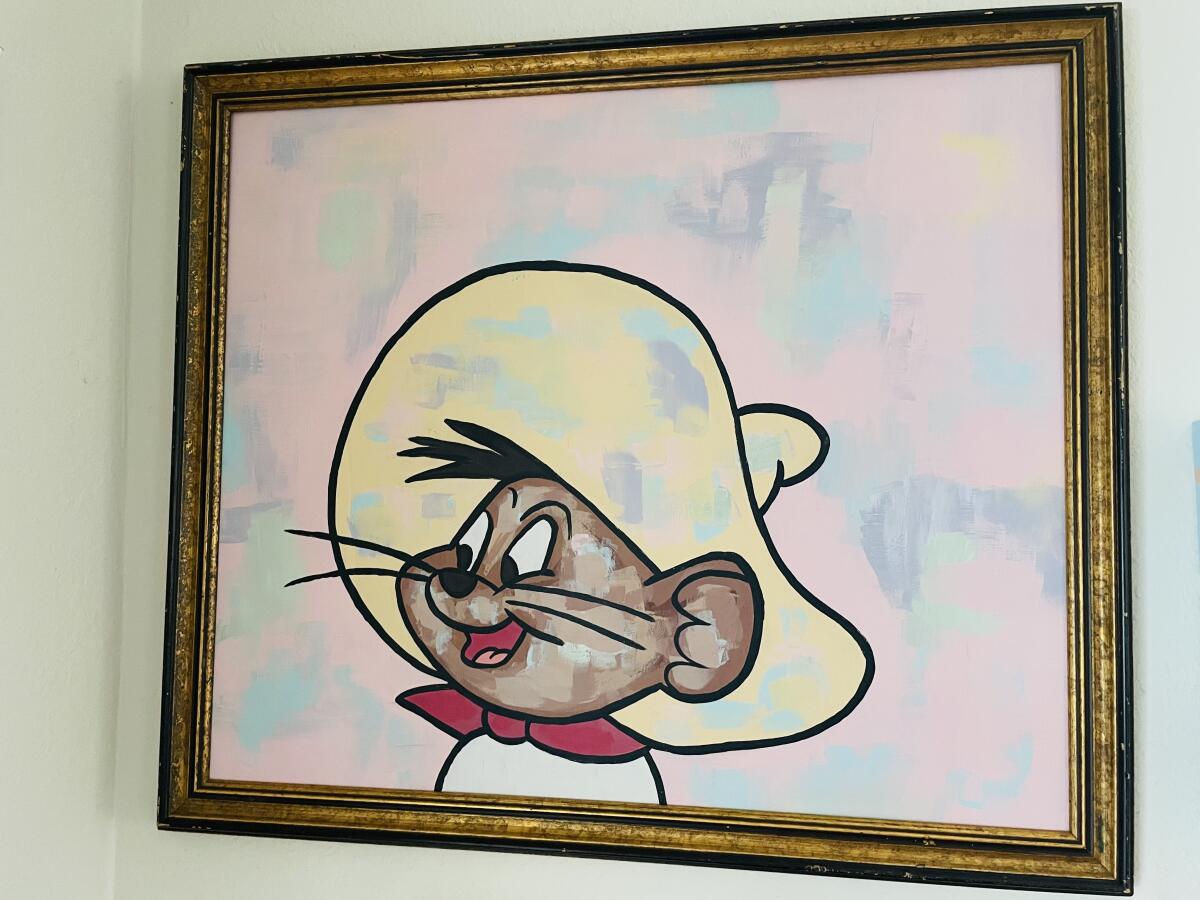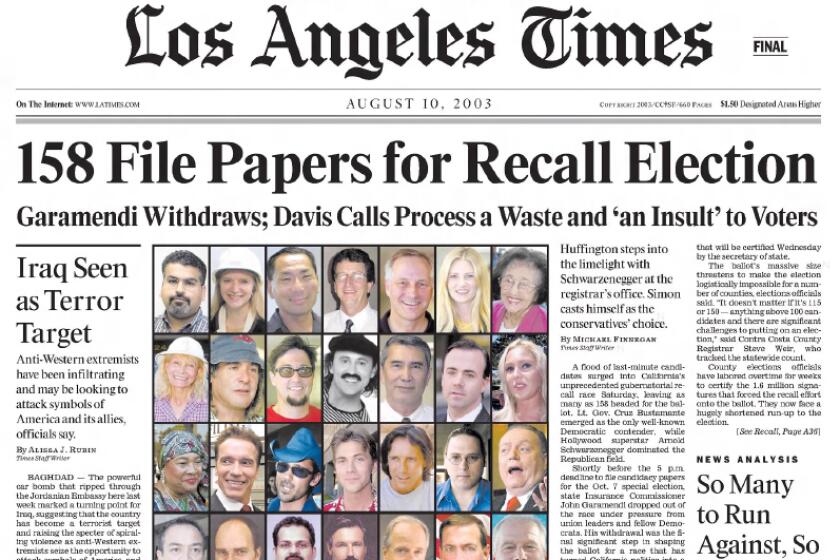Why do so many Mexican Americans defend Speedy Gonzales?

- Share via
He blazed through my childhood like a sombrero-clad comet, terrorizing gringo villains in the name of us downtrodden Mexicans.
His war cry went straight from our televisions and movie screens into our hearts and minds. My family and so many others cheered on his exploits, imagining ourselves as soldiers in his brigade. Polite society told us we shouldn’t worship this bad hombre because he made Mexicans look bad. So they tried everything possible to dim his star — but we Mexicans always fought loudly against any attempts to cancel our compadre.
Pancho Villa? Emiliano Zapata? Vicente Fernandez?
Try Speedy Gonzales.
The Warner Bros. cartoon mouse debuted in 1953 and immediately became a hit on both sides of the U.S.-Mexico border. His plots were always simple — Speedy antagonized Sylvester the Cat and other assorted felines, usually in a dispute involving cheese — but effective. The raza rodent quickly picked up awards (four Oscar nominations and one win in just six years) but also critics who saw Speedy for what he is:
Problematic. A stereotype. No doubt about it.
His name comes from a popular 1950s-era anti-Mexican sex joke. The non-Latino voice actor Mel Blanc voiced “the fastest mouse in all of Mexico” with a stereotypical accent and nonsense Spanglish. The typical Speedy plot casts him as a thief and a cad, and his fellow Mexican mice as lazy, drunk and happily living amongst trash. Did I mention the sombrero? It’s as big as his body. Sombreros are big — but not that big.
Speedy turned into a pariah in the decades after his heyday, placed by Hollywood executives and pundits in the same racist purgatory of Old Hollywood as Stepin Fetchit, “We don’t need no steenkin’ badges,” and Charlie Chan. ABC banned him from its airwaves during the 1980s “because the title character presents a stereotypical image that is not offset by any other Latino television characters,” according to a 1981 Los Angeles Times story. The Cartoon Network did the same in the late 1990s. Recently, New York Times columnist Charles Blow said Speedy cartoons “helped popularize the corrosive stereotype of the drunk and lethargic Mexicans.”
And yet time and time again, Mexicans — the very group you’d think would hate Speedy the most — rose to defend his honor.
During the 1990s, college students cast Speedy as a proto-Zapatista who fought against American imperialism before it was cool to do so. In 2002, the League of United Latin American Citizens asked the Cartoon Network to free Speedy from his jail — a spokesperson told Fox News, “How far do you push political correctness before you can’t say anything about anything anymore?”
In the wake of Blow’s columns, Mexicans famous and not spoke out on social media against those who dared decry their man. “U can’t catch me cancel culture. I’m the fastest mouse in all of Mexico,” tweeted comedian Gabriel Iglesias, who’s voicing Speedy in the upcoming “Space Jam” reboot.
Pepé Le Pew won’t reprise his “Space Jam” role in the sequel, but the cartoon skunk was cut before a writer recently linked the character to rape culture.
“We LOVE Speedy because he’s smart and fast,” wrote Eugenio Derbez, another comic who will voice him in his upcoming Speedy feature.
Meanwhile, just a handful of Latinos were nominated for this year’s Academy Awards — but Iglesias, Derbez, and other Speedy defenders don’t seem to care. I actually get it: In the 100-plus years of Tinseltown, he remains the most popular and successful Mexican character ever created. When we don’t have much, we gotta protect what we have, you know?
Speedy’s four Academy Award nominations tie him with Anthony Quinn for most ever by an actor of Mexican descent. His sole win, for an eponymous 1955 cartoon, places Speedy behind Quinn’s two Oscars for most earned by a Mexican actor… because no other Mexican man has ever won an Oscar for acting ever.
Chris Rock put this outrage best in a 2014 Hollywood Reporter essay where he described Los Angeles as a place where “there’s this acceptance that Mexicans are going to take care of white people ... that doesn’t exist anywhere else.” Decrying the lack of representation in Hollywood, Rock cracked “You’re in L.A., you’ve got to try not to hire Mexicans.”
The 2021 Oscar nominations celebrate actors, actresses and directors of color. But Latinos are mostly shut out from the top categories.
Instead, Hollywood hires Speedy. What other “Mexican” thespian has two big-budget projects slated for next year? Not Edward James Olmos or Salma Hayek.
I’m no spoilsport or wokoso (a portmanteau of “woke” and a mocoso — a snot-nosed brat) about the cute rascal. I never saw a stereotype when I first saw his cartoons as a boy — I saw my culture at a time when the English-language media didn’t bother with us outside of crime and immigration. He danced our dances and dressed like a jarocho (a native of Veracruz) and sounded like my country cousins, to be honest. He was the only Mexican in Hollywood I knew who never lost — well, him and Cheech and Chong.
I love Speedy so much, I keep a large painting of him in my home office. His kind smile and brown skin takes me back to my childhood — and reminds me of where we as Mexicans exist today.
Of course we’re going to love Speedy — it’s not like we have a buffet of iconic animated heroes to choose from besides Dora the Explorer and Bender Bending Rodriguez from “Futurama.”
This unlikely love affair fascinates Louisiana State University history professor Stephen Andes, who’s working on an academic book about Speedy.
“It speaks about the robustness of Latino audiences who are taking the little bit that they were given and finding something they connected with, and then making Speedy into a hero,” Andes said. “If Gabriel [Iglesias] feels like it means something to play Speedy, I’m not going to tell him he can’t do that.”
Andes says that’s why Speedy shouldn’t be tossed into the same dustbin as his contemporaries the Frito Bandito, Jose Jimenez, or Blanc’s own Sy the Little Mexican character on “The Jack Benny Show.”
He points out that Mexican American animators worked on nearly half of the 47 Speedy Gonzales shorts, at a time where they were a rarity in Hollywood. In Latin America, audiences continue to love Speedy with little compunction because they accept him at face value — a Mexican mouse who makes a mockery out of Yankee pussygatos again and again.
“That’s not an excuse or a justification for ‘Oh, well if a Mexican American did something problematic, it, it’s all fine,” Andes says. “But that actually nuances his story. It needs to be acknowledged it was a really problematic bit of representation that Mexicans molded into an icon.”
Just don’t get me started about Speedy’s rat-faced cousin, Slowpoke Rodriguez.
More from Gustavo Arellano
More to Read
Sign up for Essential California
The most important California stories and recommendations in your inbox every morning.
You may occasionally receive promotional content from the Los Angeles Times.

















